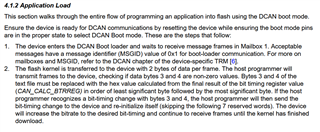Tool/software:
Hello,
I am working with LAUNHXL-F2800157 and following the DCAN CAN Flash Programming Guide to configure the CAN bus bitrate. The guide instructs modifying bytes 3-4 in the generated flash kernel text file to "C0 7A" to set the desired bitrate.
I understand that these bytes contain metadata for bitrate configuration, but I'm seeking a detailed explanation of the transformation process that leads to the specific values "C0 7A". Could someone please clarify how these values are derived?

For context, my CAN clock (CANCLK) is set to [e.g., 20 MHz], and I'm aiming for a bitrate of [e.g., 100 kbps].

Thank you in advance for your assistance.
Best regards,
Taif


